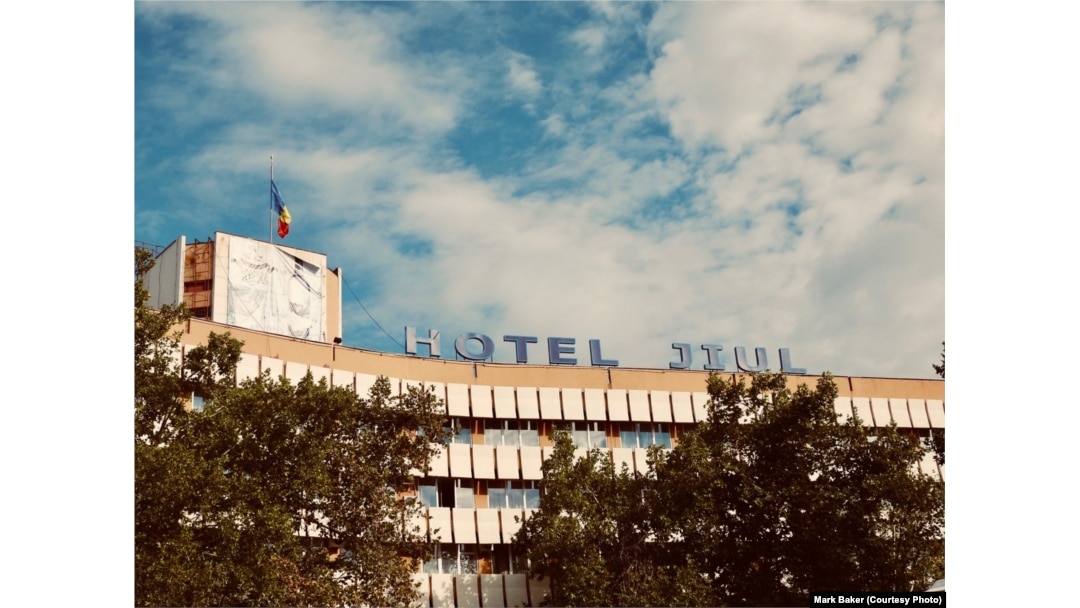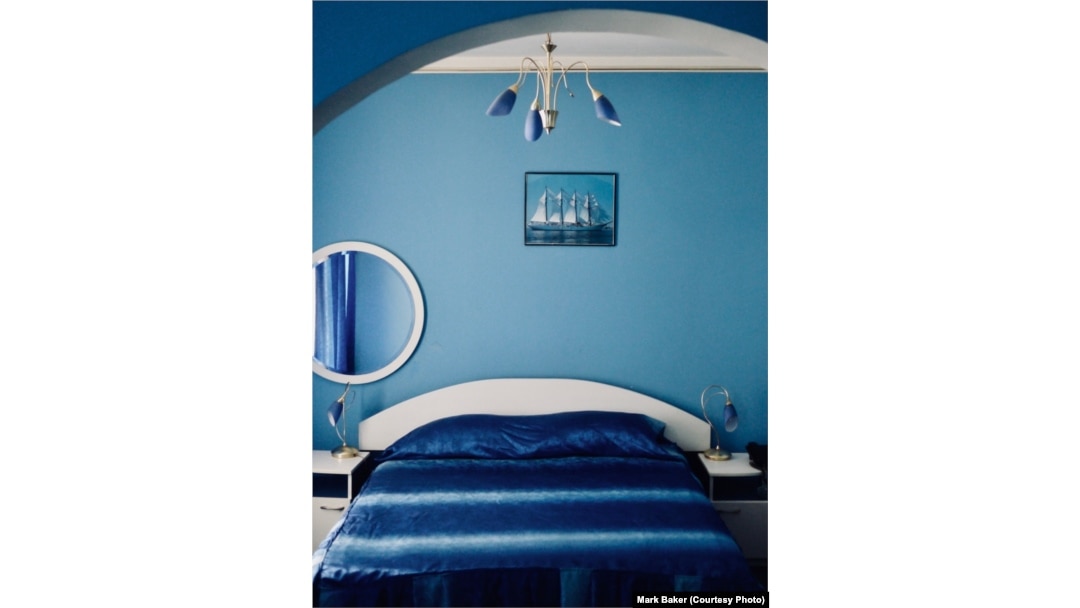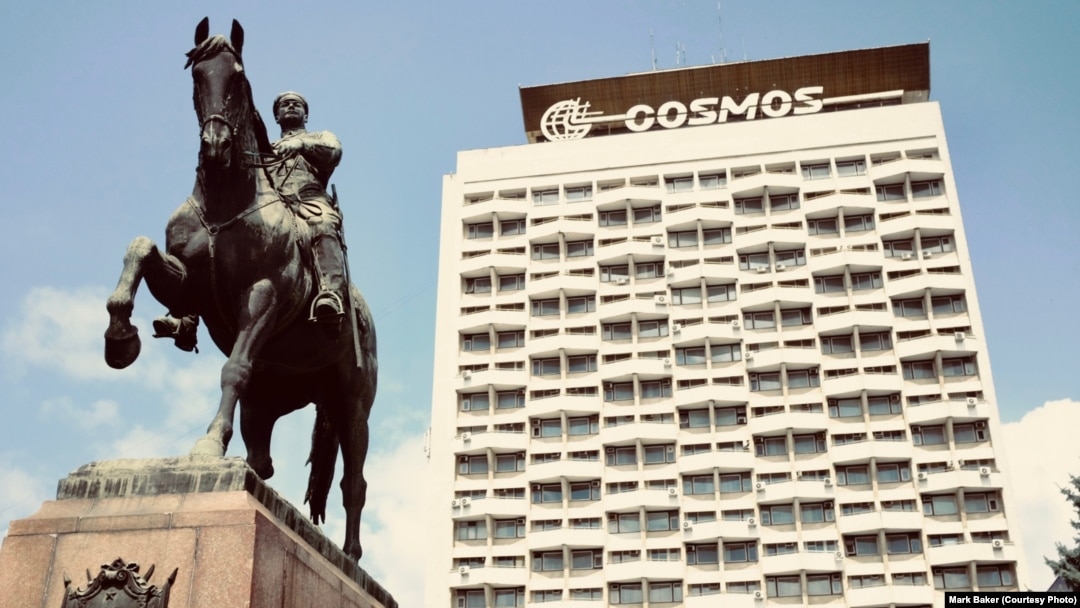In my travels around Central and Eastern Europe during the past three decades, first as a journalist and later as a travel writer, I’ve stayed at a lot of hotels in the region.
Since the fall of communism in 1989, the number of lodging options has exploded. Big hotels, small hotels, pensions, B&Bs, Airbnbs, hostels -- basically anything you’d find anywhere else, you’ll find here. And the standards have risen dramatically.
But I still have a soft spot in my heart for those big, communist-era, high-rise hotels.

The Hotel Jiul in Craiova, Romania, was closed in 2015 and remodeled beyond recognition by the acquiring Ramada Inn group. In its day, the Jiul was one of the cheapest, creepiest, and most memorable communist-era hotels in the country.

The interior of one of the first-floor suites at the Hotel Jiul in Craiova, Romania. Caught somewhere in the 1970s, the walls were creamy blue and the bedcovers a dark-blue velvet. David Lynch would have felt quite at home.
It may not be obvious now, but if you happened to be traveling through any city of any size in Central or Eastern Europe before 1989 and were looking for some action -- and by this I mean a meal, some drinks, and maybe a bar or club -- chances are the only place in town you’d find it would be at the city’s central, state-run hotel.
For years, the airy lobby of the Hotel Thermal in Karlovy Vary, Czech Republic, was stuffed with these retro-futuristic bright red chairs. I always admired the lobby's polished, stylish interior, which compensated in part for the aggressive exterior (below).
You could always tell these places by their very consciously Socialist names, such as “Mir” (Peace) or “Druzba” (Friendship) -- or grand city names like “Moskva” or “Riga.”
They not only had the best rooms in town, they often had the finest (or at least most expensive) restaurants and bars. Many also had risque nightclubs, invariably referred to as “gentlemen’s clubs,” with names like the “Black Cat,” though these were usually as uninviting as their Western counterparts.
The legendary Thermal Hotel in the historic Czech spa resort of Karlovy Vary. A gloriously hideous hotel in a town that's filled with beautiful but somehow bland 19th-century spa and hotel architecture. The rooftop swimming pool was famous during communist times, but it has been sadly left to rot away (the last time I checked).
Back then, the hotels were usually operated by a state-controlled hotel chain, with an outwardly tourist-friendly name hiding what was, in fact, a cheerless arm of that country’s Interior Ministry or Communist Party.
Russia’s state-run Intourist travel agency was the model, but all of the smaller countries had their own versions: Cedok (Czechoslovakia), Orbis (Poland), and so on.
The lobby of the Grand Hotel Ceahlau in Piatra Neamț, Romania. The designers play with color, light and materials here to create a modern, pleasing aesthetic.
It’s not immediately obvious why the party and state-security apparatus would take such a keen interest in running hotels, until you consider the fact that these places were tremendous moneymakers for the regimes.
They could charge for the rooms and meals in hard currencies (mainly, at the time, U.S. dollars or German marks) and had a captive clientele of relatively well-off foreigners to whom they could market their off-the-books services like prostitution and money changing.
There was simply too much cash floating around to pass up.
The hard '70s facade of the Hotel Cherno More (Black Sea) in Varna, Bulgaria. For years, this was one of the leading hotels in the city and is still popular.
The lobby of Varna, Bulgaria's grand Cherno More (Black Sea) Hotel, once "the" place in town for rising apparatchiks. I love how the designers have dressed up the oversized columns and painted them in retro cream and green. The hotel is still operating.
This nexus of party bosses, state-security types, local hustlers, and Western businessmen often lent the hotels a sleazy vibe.
In an earlier post on my blog on the comings and goings of Prague’s Intercontinental Hotel in the 1980s, I describe the hotel's lobby as a funk of stale Marlboro smoke and knock-off perfume. The place was filled with grubby-looking money changers and attractive female “law students” relaxing over a drink at the bar. It was depressing but -- admittedly -- pretty absorbing theater.
Once the leading address for visiting communist dignitaries, Prague's Hotel Praha was demolished in 2014 to make way for a school that was never built. The Brutalist design dates from the early '70s, though the hotel was only finally completed in 1981. All of the 136 rooms had private terraces and views out over the Old Town in the distance.
Prague's infamous communist playground, the brutalist Hotel Praha, is pictured here at demolition in 2014. It was a magnificent eyesore, with one of the best '70s-style cocktail bars ever built. Guests included Leonid Brezhnev and (much later in the 1990s) Tom Cruise.
In the aftermath of the anticommunist revolutions in Central and Eastern Europe in 1989, these hotels have tended to fare poorly. The state-run chains have mainly been broken up and sold off to private (often foreign) investors.
Some of the bigger, better-placed properties are thriving, but many of these admittedly ugly high-rises are struggling to compete with a new generation of smaller hotels, boutiques, and private offerings marketed through sites like Airbnb.
The communists loved to show off "peasant" culture, and here it is on full display in the glorious lobby of the Hotel Riga in Ruse, Bulgaria. Carved wood paired with '60s-style flowers all over a vaguely lavender flooring. A Bulgarian friend, Nik Krastev, told me the wood-carved panels were actually the work of his stepfather, Miri Nanev, in the early '70s.
This article features a collection of photos of some of my favorite Eastern and Central European hotels as they’ve appeared in the past 10 years or so that I've been writing guidebooks.
These photos show off some of the best and worst aspects of these weird demiworlds, where the spirit of the old communist regimes often lingered for years after the political structures that supported them had collapsed.
Editor's Note: This article originally appeared on the author's blog, which can be found here.
To this day, Bucharest's skyline is dominated by the sharp, weird angles of the Hotel Intercontinental. In the 1970s, the hotel was a symbol of Romania's maverick status between East and West, but the hotel plunged to the depths of sleaze in the last years of the Nicolae Ceausescu regime in the late 1980s. These days, it's back to being a decent four-star hotel
The front facade of the Hotel Continental in Drobeta-Turnu Severin, Romania. The national flags flying over a futuristic fly-out above the front entrance is a hallmark of buildings from the 1960s and '70s. The Continental chain assumed control of many of Romania's communist-era hotels and manages them to this day.
The oversized Cosmos Hotel in Chisinau, Moldova, a classic example of 1970s Soviet gigantism that's failed to find a natural clientele in the modern era. The rooms are too small and poorly fitted out to command the prices that management would need to improve the property. We'll see what happens.
The towering Hotel Muntenia in Pitești, Romania. A typical communist-era white elephant in that it's too large to maintain, yet the rooms are too small to command luxury prices. Last time I checked, it was still mostly empty yet still going strong.
The elegant, traditional lobby elements of the Hotel Muntenia in Pitești, Romania, show an almost 1950s' Socialist-Realist influence. In my experience, Socialist-Realist buildings often have very elaborate, even bourgeois, interior design elements, as if they plan was to create luxury for the working man.
Smaller cities, such as Targoviste, Romania (pictured here), grew to depend on their communist-era, high-rise hotels (like the Dambovita Hotel). These were often the best (or only) places to stay and functioned as local centers of power.
Sadly, this yellow leatherette chair ensemble in the lobby of the Dambovita Hotel in Targoviste, Romania, had been replaced on my last visit. Part of the design aesthetic seemed to be to push bad taste to extreme boundaries, firmly into "so bad, it's good" territory.
Prague's Hotel International, a perfectly preserved example of 1950s' Socialist-Realist architecture. The hotel was a 'gift' from Stalin, and the Czechs showed their gratitude by building it on the far outskirts of the city.
The formal elegance of the reception area of Prague's 1950s' classic Hotel International. Many of the hotels built in this early phase of communist architecture in Eastern Europe boasted lobbies and interiors that could rival the best in the West at the time. Unfortunately, the style did not carry to the tiny, plain rooms.
A view of Prague's Hotel International in the distance. When Stalin offered the Czechs a Socialist-Realist tower of their own in the early 1950s, Prague authorities opted to build it in a bucolic residential district -- far from where anyone might see it.
One of the highlights of the Hotel International's intact '50s period interior is the tapestry of Prague's Old Town on one of the lobby walls. At the top of the tapestry, you can easily make out the massive statue of Stalin that stood at the top of Letna park from 1955 to 1962.
The sumptuous interior of the Hotel Balkan in Sofia, Bulgaria, is another example of the influence of 1950s' Socialist-Realist interior design. The hotel served as the capital's No. 1 address for years and later benefited from investment and design help from the Sheraton chain.
The Hotel Unirea towers over the center of Iaşi, Romania. I've stayed here several times over the years and admire its soulless anonymity and pretty views over the square.
The imposing Hotel Riga in Ruse, Bulgaria. A communist-era adaptation of the international style that reigned in the West from the late 1950s to the 'early '70s. Once the city's top address, the Riga is still a comfortable place to stay with beautiful views out over the Danube River.
The glorious communist-era monument to the city of Rzeszów, Poland, pairs well with the Hotel Rzeszów's rectilinear architecture (in the background). The '70s-style hotel has since been remodeled and is a very nice and comfortable four-star hotel.
The old Hotel Forum in Krakow, Poland. This was once the grandest place to stay in the city. It's a Brutalist gem that dominated the riverfront and took years to build through the 1970s but quickly fell out of favor.
The 1970s-'80s Brutalist Hotel Forum in Krakow no longer functions as a hotel, but has been re-purposed into a laid-back coffee joint, bar, and restaurant: the Forum Przestrzenie. The cafe plays on the building's former role and retro accents, and shows how these old eyesores can be reused.
The front of the Grandhotel Starý Smokovec, a mountain resort in Slovakia's High Tatras that could easily stand in for Wes Anderson’s “Grand Budapest Hotel.” That movie was shot in Görlitz, a lovely time capsule on the Polish-German border, but the real-life experience was available to anyone traveling to the High Tatras
Another shot of the gorgeous alpine-baroque architecture of the 19th-century Grandhotel Starý Smokovec in the Slovak Tatra mountains. The structure obviously predates the advent of communism in Czechoslovakia. These older bourgeois hotels often posed an ideological challenge for the regimes and were sometimes given dramatic flourishes, such as the statue out front, to give them a more politically correct (for the times) aspect.


